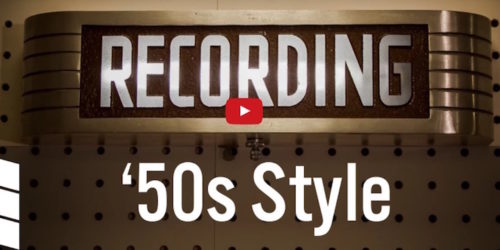- in Production , Recording , Video by Bobby Owsinski
- |
- 1 comments
Recording 50s Style
 While we live in an period of unlimited DAW tracks, there’s still much fascination with the time where there were far fewer variables, and that means the mono world of the 50s. In that era and the one that immediately followed, mixing held little resemblance to today, since all the magic took place in the recording. Placement of the players and the mics was king then. Get that right and the mix would take care of itself.
While we live in an period of unlimited DAW tracks, there’s still much fascination with the time where there were far fewer variables, and that means the mono world of the 50s. In that era and the one that immediately followed, mixing held little resemblance to today, since all the magic took place in the recording. Placement of the players and the mics was king then. Get that right and the mix would take care of itself.
While many engineers look back at that era in awe, some take it to an extreme, and that’s what you’ll find at Sugar Ray’s Vintage Recording Studio in Wickford, Essex, UK. Owner Dean Amos has gone to great lengths to reproduce a studio that would make Sam Philips proud, duplicating everything as closely as possible (even down to the pegboard on the wall) to the studios of that era. The signal path is exactly what Norman Petty (Buddy Holly, Roy Orbison, Waylon Jennings) used in 1958, which include Altec 1567a and Collins mixers, Altec 436C compressors, Pultecs EQs, RCA 44 mics, and mono Ampex 350 tape machines. The studio also has a rare Ampex 300 half-inch 3 track machine
One of the things that engineer/producer Lincoln Grounds points out is that EQ and compression doesn’t work as you expect in that type of recording environment. Add some low end EQ on the vocal and the acoustic bass level might increase. Add some vocal compression and the reflections of the room might show how boxy the space really is. In order to get the effect you need, you have to move both the player and the mic first.
This type of recording is a great learning ground and I wish that all recording programs started their students this way. It could provide a much more solid foundation that they seldom get now in a world of samples, DAWs and unlimited tracks. Having the limitations of the 50s when you’re learning will pay dividends down the road. Check out the video and the Sound on Sound article!

